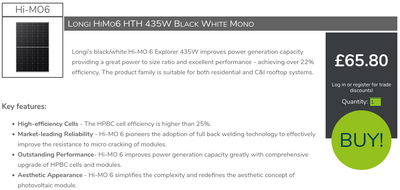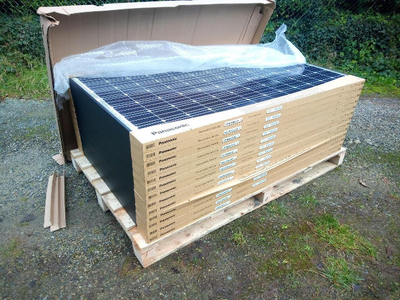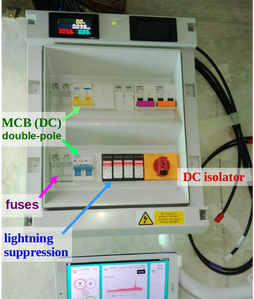Solar inverters - where does the energy go when clipping?
The first law of thermodynamics states that energy can't be created or destroyed, so where does the excess clipped energy go when a solar array is generating 4kW on a sunny day but the inverter clips it's output to 3.6kW? Is the 400W of clipped energy lost as heat from the inverter? My inverter is in the loft so I've no idea how hot it gets on a sunny day.
Samsung 12kW gen6 ASHP with 50L volumiser and all new large radiators. 7.2kWp solar (south facing), Tesla PW3 (13.5kW)
Solar generation completely offsets ASHP usage annually. We no longer burn ~1600L of kerosene annually.
Posted by: @old_scientistThe first law of thermodynamics states that energy can't be created or destroyed, so where does the excess clipped energy go when a solar array is generating 4kW on a sunny day but the inverter clips it's output to 3.6kW? Is the 400W of clipped energy lost as heat from the inverter? My inverter is in the loft so I've no idea how hot it gets on a sunny day.
Einstein!! I think we lose it in heat in the inverter, don’t need to worry about that in the winter, solar is useless then. I’m thinking wind might be a better option if someone comes up with a decent device
Posted by: @old_scientistThe first law of thermodynamics states that energy can't be created or destroyed, so where does the excess clipped energy go when a solar array is generating 4kW on a sunny day but the inverter clips it's output to 3.6kW? Is the 400W of clipped energy lost as heat from the inverter? My inverter is in the loft so I've no idea how hot it gets on a sunny day.
It's a good question and one which I have asked myself. We really need a solar panel physicist to answer, I am a lapsed physicist but never really studied this particular specialty.
Firstly I doubt the panel does generate 4kW when clipped, because it's not correctly loaded, but for sure the solar energy does still hit the panels, so the question remains valid albeit slightly modified.
I think that when it is clipping the inverter presents less than a matched load to the panels, so I suspect some of the energy is absorbed by the panels resulting in them heating up more than would otherwise be the case. I could easily believe that, in addition, there is an effect on the reflectivity, but definitely don't know this to be the case.
As you say it has to go somewhere, the above seems plausible at least .
It's worth bearing in mind that solar panel efficiency has remained stubbornly around 20% for a decade more. This being the case some additional excess energy lost to heat is unlikely to cause anything to melt.
4kW peak of solar PV since 2011; EV and a 1930s house which has been partially renovated to improve its efficiency. 7kW Vaillant heat pump.
I understand that it gets dissipated as heat, mostly in the panels but some in the inverter. Since most solar power generates heat in the panels (80%) because they are only 20% efficient the extra heat isn’t a lot. We don’t need spurious heat though!
2kW + Growatt & 4kW +Sunnyboy PV on south-facing roof Solar thermal. 9.5kWh Givenergy battery with AC3. MVHR. Vaillant 7kW ASHP (very pleased with it) open system operating on WC
In the solar panels.
On a nice sunny day, a square metre of panels would get 1kW from the sun. Of this we might expect 200W of electical power if a suitabel MPPT inverter is connected, and then 800W as thermal power warming up the panel itself. If you disconnect the panel, then the whole of the available 1000W will heat up the panel.
When the inverter MPPT backs off, it just leaves some of the power in the panel. If could choose the best MPPT point and to dissipate the excess power in itself instead - but no inverter will do this, as it would cause overheating and unreliability in a physically small inverter, while the panels are designed to be able to dissipate the thermal power.
Not that it's a good idea to leave panels in the sun unconnected - I think eventually they do get damaged this way for some reason.
Why do panels get damaged if not connected?
When they are normally in the sun, they get 800W/m^2 evenly distributed, and they warm up everywhere. Silicon doesn't like being super hot for too long, it will eventually degrade, but it's a long term problem.
I think if you leave a panel disconnected, you can think of the extra 200W/m^2 as actually electrically generated and then dissipated by the panel itself. The graph above shows that as temperature increases, the open circuit voltage of a PV panel drops - a positive feedback effect. So I would expect an unconnected panel to have hotspots where the current flows, and these will degrade it faster.
@robl thank you, makes perfect sense, and my wife is relieved to know the inverter isn't sat in the loft smouldering due to excess heat because of an oversized array.
Samsung 12kW gen6 ASHP with 50L volumiser and all new large radiators. 7.2kWp solar (south facing), Tesla PW3 (13.5kW)
Solar generation completely offsets ASHP usage annually. We no longer burn ~1600L of kerosene annually.
Very enlightening discussion.
I know we will be a pain to the PV installers we will hire, but..
We are wondering what to look for panels considering temperatures etc - to install in SE England.
Quick googling showed me this:
The way things look, we may have G99 for the inverter with 5kw before the project execution starts.
16kWh Seplos Fogstar battery; 8kW Solis S6-EH1P8K-L-PLUS hybrid inverter; Ohme Home Pro EV charger; 100Amp head, HA lab on mini PC
Since the combination of fitting plus scaffolding makes a big proportion of the price it doesn’t look as if it matters much. I’m surprised that mono-crystalline doesn’t have a price premium since the difference used to be larger. Your actual quotes might not align with the marketing presentation!
2kW + Growatt & 4kW +Sunnyboy PV on south-facing roof Solar thermal. 9.5kWh Givenergy battery with AC3. MVHR. Vaillant 7kW ASHP (very pleased with it) open system operating on WC
Absolutely right! 🙂
And not all will quote once they see a hybrid inverter ready/approved. We rarely see installers actually praise what was already there..
16kWh Seplos Fogstar battery; 8kW Solis S6-EH1P8K-L-PLUS hybrid inverter; Ohme Home Pro EV charger; 100Amp head, HA lab on mini PC
I think I must query the sources on which Greenmatch have based their prices @batpred
Did they provide source references?
One of the major UK Wholesalers will also sell to the general public.
That's Midsummer Wholesale, near Cambridge.
Look at today's price for a typical Longhi 435W mono-crystalline panel
You'd need to add VAT and carriage to that retail price.
Typical pallet-rate carriage would be around £100-£150 depending on the number of panels on it
The datasheet is on that same page.
It contains graphs of tail-off of generation over time, temperature ratings etc.
Can I suggest that you avoid buying Trina solar panels.
They have been blacklisted by MOD (for example) due to the use of Uyghur slave labour.
You'd then select a rooftop rail-mounting system, such as Fastensol.
The rails themselves are light, but come in 3.55m lengths.
The Fastensol Manual (installation guide) is available on the pages for the Roof Hooks
However, @judith is quite correct to point out that the two main costs are:
- scaffolding
- labour
and those are completely dependent on your roof design & access.
Posted by: @batprednot all will quote once they see a hybrid inverter ready/approved.
It all rather depends on whether you need to end up with an MCS installation number.
You'd need that if you ever intend applying for the Smart Export Guarantee (SEG) to earn income from exporting to the grid.
If the SEG is irrelevant because your inverter isn't going to export, then you don't need an "MCS approved" installer.
You either do it yourself or employ a local roofer.
A solar-panel installation company will also want to have a say in what goes on the end of the wires.
Some companies will insist on an enclosure (a "string combiner") which contains isolators, fuses and anti-lightning suppression.
Others will check what's already offered within the inverter, and be happy to terminate wires with MC4 connectors for direct connection.
Whoever does the work, there needs to be care taken over EARTHING
At some point in the lifetime of the panels your house will be in the path of a thunderstorm.
Even if there is no direct lightning strike, an earth-path will move electrons (or "positive holes") up to the panels in order to counter the electromagnetic charge in the clouds.
Most installers do not earth the electrical connections to the panels.
Some might insist that the roofing rails are separately earthed.
Each location is different.
Earthing needs to take into account the mains supply to the property (PME supplies have earth tied to neutral by the DNO)
and what earths have been installed for any EV chargers.
Ignoring earthing is not an option!
Save energy... recycle electrons!
- 26 Forums
- 2,357 Topics
- 53.5 K Posts
- 176 Online
- 6,025 Members
Join Us!
Worth Watching
Latest Posts
-

RE: Setback savings - fact or fiction?
I could, but I think we can do better, by plotting hour...
By cathodeRay , 9 hours ago
-
RE: Midea ASHP – how to set weather compensation
Just one more thought. If you have convenient space fo...
By JamesPa , 10 hours ago
-
RE: Advice on internal circulation pump noise
Extend the primary branch and make sure you have more t...
By ASHP-BOBBA , 11 hours ago
-

RE: External pipework insulation
Oh Dear! that's appalling pipe work, should've been in ...
By dgclimatecontrol , 16 hours ago
-

RE: Jokes and fun posts about heat pumps and renewables
By Morgan , 17 hours ago
-

RE: Controlling Daikin Altherma via P1P2 and Home Assistant
On the contrary, @toodles, that’s a lot of help. I’d ne...
By Majordennisbloodnok , 18 hours ago
-
RE: Octopus Cosy Heat Pump Owners & Discussion Thread
@kevh with the Cosy 6 I know it definitely goes to arou...
By HarrisonC , 1 day ago
-

Parsnip, Bacon & Coconut Milk Soup
First let me say, I am only a cook because I am human a...
By Toodles , 1 day ago
-
RE: Electricity price predictions
Ben Watts posted on LinkedIn that he had updated this w...
By Judith , 2 days ago
-

RE: The good, the bad and the not that great – my heat pump installation
Small update, Emailed and Spoke to Midea UK and they ...
By Burtis , 2 days ago
-
RE: Solis S6-EH1P8K-L-PLUS – Why I Chose It and What I’ve Learned So Far
@bash Octopus does charge for the admin. The process al...
By Batpred , 2 days ago
-
RE: New Fogstar 15.5kWh upright solution
Issues still under investigation by Solis... Fogstar ...
By Batpred , 2 days ago
-
RE: Who's your electricity provider and what's your tariff?
I agree, the consumer is not being properly represented...
By Batpred , 2 days ago
-

RE: Heat Pump Heats the House… But It’s Not Cosy. Emitter Changes or System Tweak?
@toodles interesting suggestion, thanks. I will try to...
By GrahamF , 2 days ago
-
RE: Mitsubishi Ecodan Auto Adaption trial to stop cycling.
The interval you talk of, i think, will be 60min for an...
By F1p , 2 days ago
-
Agree with @majordennisbloodnok on the setbacks. We hav...
By ChandyKris , 3 days ago
-

RE: Speedcomfort radiator fans
@deltona the way the links were added broke the page. A...
By Mars , 3 days ago
-

RE: Refrigerant R32, is it now banned in the EU from 1st Jan 2027 for monobloc ASHPs?
This has been delayed from what I believe to be this ye...
By dgclimatecontrol , 3 days ago









